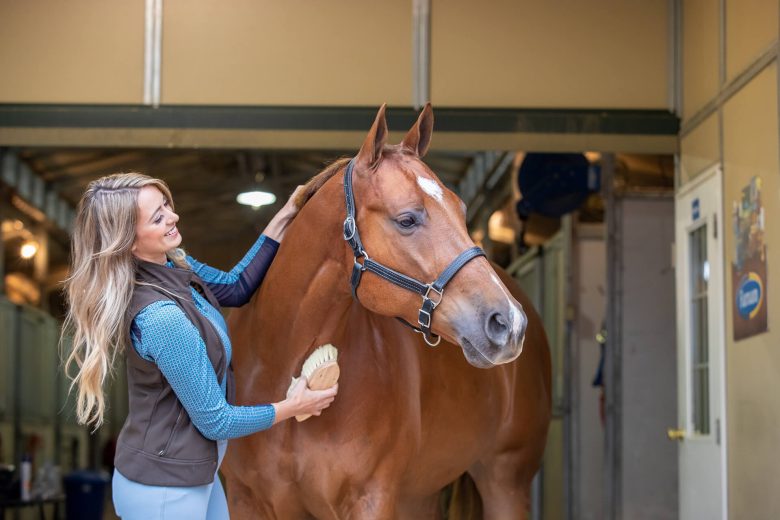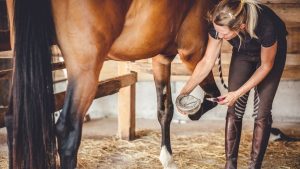Grooming is an important part of caring for your horse and goes beyond just making sure it looks good. This is also very important to keep them healthy and happy. Regular care can keep your horse’s coat clean and shiny, while also allowing you to monitor his health. This guide covers many effective horse-cleaning techniques. It covers everything from everyday life to professional care techniques.
Daily Grooming Routine:
Establishing a daily cleaning routine is the best way to keep your horse healthy and happy. First, carefully comb your horse’s body with a curry comb to remove dirt, loose hair, and sweat. Then use a stiff brush to remove any remaining dirt and apply natural oils for a shiny coat. Pay special attention to areas prone to injury, such as the face, legs, and abdomen.
Then use a hoof pick to gently clean the footing and remove any dirt and grime in the cracks. To prevent infections and keep your hooves healthy, you need to groom them regularly. Also check the inside of your eyes, ears, and nose for moisture or other problems.
Bathing Techniques:
To keep your horse’s skin and coat in good condition, daily grooming and frequent bathing are required. Use warm water and a mild horse shampoo. Make sure that no shampoo gets into your eyes or ears, as these are sensitive areas. Rinse the horse thoroughly to remove soap residue and ensure it is completely dry before returning it to its original location.
When bathing your horse, pay attention to his body language, as some horses can be afraid of water. Bath them gradually and use the positive feedback to build a good connection with the experience. By drying your horse correctly you can prevent skin problems and pain.
Mane and Tail Care:
In addition to the fact that a horse looks beautiful, the mane and tail can also be an indication of a horse’s health. To prevent your mane and tail from getting tangled, comb them regularly and use a detangling spray if necessary. Trim your hair as necessary and make sure it stays neat and even.
To care for your tail, slowly work your way up from the base to remove any knots or tangles. Trim the tail regularly to keep it at a manageable length and prevent breakage.
Things to Consider for Professional Beauty:
In some cases, you may need additional care. For example, if your pet is shedding, use a hair removal blade or comb block to remove loose hair more quickly. This prevents the coat from becoming tangled and promotes healthy new coat growth.
Also, consider how to clean horses with different coat types. For example, horses with white or light-colored coats need special shampoos to whiten the coat and keep it bright. Horses should always be cared for in a way that suits their needs and personality.
If your pet is injured or has skin problems, you should talk to your vet about the proper way to clean it. Using the right ointment or treatment and gently cleaning the area can help it heal and prevent the problem from worsening.
Devices Care:
Nursing supplies should be cleaned and inspected regularly to ensure they are working properly and to stop the spread of infection. It is important to regularly disinfect brushes, combs, and other cleaning tools. Replace damaged or worn tools quickly. Well-maintained equipment not only makes cleaning your horse more fun but also extends the life of your tools.
Conclusion
Incorporating good cleaning techniques into your horse care routine isn’t just about making the horse look better, it’s about making the horse better. This is an important part of being a responsible horse owner. You can promote your horse’s health and well-being by grooming him daily, bathing him properly, grooming his coat and tail, meeting any special grooming needs, and keeping his tools in good condition. A well-cared-for horse not only looks good but also reflects the care and dedication of its owner.
FAQs
1. Why is it important to clean your horse?
Horses need care for various reasons. It helps keep your coat clean and healthy, stops skin problems, improves circulation, and allows you to detect wounds or health problems early. Moreover, care creates a bond between horse and rider.
2. How often should I clean my horse?
Horses should be cleaned daily if possible. This exercise removes dirt, sweat, and loose hair to keep your skin healthy and your coat shiny. But the amount of cleaning can vary depending on factors such as where the horse lives, how active it is, and its own specific grooming needs.
3. What is the best way to brush a horse’s hair?
First, use a curry comb to comb out dirt and hair. Then use a stiff brush to remove debris and apply natural oils. Be gentle around sensitive areas and use a soft brush for a smooth finish. Regularly brushing your dog’s coat not only keeps your dog clean, it also strengthens the skin and gives your dog a healthy glow.
4. Is it okay to wash my horse regularly?
Occasional bathing is important, but bathing too often can strip the natural oils from your horse’s coat, which can lead to dehydration and skin problems. Normally cleaning your horse every four to six weeks is sufficient, but you should vary this depending on your horse’s lifestyle, weather, and specific needs.
5. How should you wash a horse when he is scared?
Start washing your baby gradually and use positive feedback. Start with a low-pressure hose, focusing on areas where the horse is accustomed to moisture. Reward your horse with a treat or compliments so that he positively views the event. As the horse gets used to it, gradually increases the water flow.
6. What do I need to clean and care for my horse?
Curry combs, hard brushes, soft brushes, hoof picks, brush and tail combs, throwing knives or comb blocks (during the shedding season), and pruning shears are some of the most important cleaning tools. Clean and disinfect these tools regularly to keep them working properly and prevent illness.



